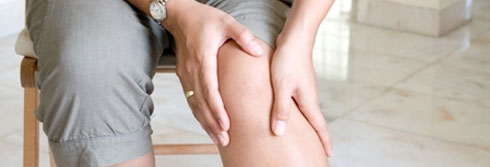
General Knee Pain
The most common causes of knee pain are:
- Anterior Knee Pain
- Patella Tendinopathy
- Fat Pad Irritation/Impingement
- Lateral Knee Pain
- Medial Knee Pain
- Posterior Knee Pain
Anterior Knee Pain
Anterior knee pain (pain at the front of the knee) is one of the most common presenting symptoms in our clinic. Two common causes of anterior knee pain are patellofemoral syndrome (a term used to describe pain in and around the knee cap) and patella tendinopathy (pain caused from the patella tendon). Fat pad impingement is an undiagnosed cause of anterior knee pain that may mimic features of patellofemoral syndrome and patella tendinopathy.
The onset of typical patellofemoral pain is often insidious but may be present after an acute traumatic episode (e.g. falling on the knee). There is often a diffuse ache, which may be exacerbated by either prolonged sitting or activity. Pain during running that gradually worsens is more likely to be of patellofemoral origin, whereas pain that occurs at the start of activity, settles after warming up and returns after activity or the next morning is more likely to be tendinopathy.
A history of recurrent clicking may suggest patellofemoral syndrome; people may also describe a feeling of giving way with patellofemoral syndrome. It is thought that patellofemoral pain is caused by malalignment relative to the groove in the femur which causes abnormalities within the articular cartilage. Correction of the malalignment therefore decreases the person's symptoms and evens out the loading of the articular cartilage.
The management of patellofemoral syndrome requires an integrated approach which involves,
- Reduction of pain and inflammation
- Taping to correct abnormal patella position and relieve pain
- Specific muscle strengthening to improve the loading of the lower extremity so the forces can be spread more evenly through the patellofemoral joint. Stockport Physio provide a graduated supervised strengthening programme aimed at training the vastus medialis oblique and gluteus medius muscles which are the main muscles involved in the biomechanics of the lower limb and in control of the patella.
- Stretching of tight structures on the outside aspect of the knee joint.
- Massage therapy to release tight structures
- Correction of abnormal biomechanics
Patella Tendinopathy
First referred to as 'jumper's knee' due to its frequency in jumping sports (e.g. basketball, volleyball, long and triple jumps). It can occur in people who do not perform a lot of jumping. It is a degeneration of the patella tendon. Pain is felt at the front of the knee or just below the patella and is aggravated by activities such as jumping, hopping and bounding. Pain is usually of gradual onset. Many cases of patella tendinopathy coexist with patellofemoral syndrome.
Rehabilitation can be a lengthy process requiring load reduction by correcting biomechanical errors, ice treatment. appropriate strengthening exercises and massage therapy. Surgery is rarely necessary.
Fat Pad Irritation/Impingement
This is a condition where the fat pad at the base of the patella becomes impinged between the patella and the condyle of the femur. It can be extremely painful and debilitating. It often goes unrecognised by many therapists. The pain is often exacerbated by fully straightening the knee and prolonged standing. Treatment involves taping of the patella, muscle training and improving the biomechanics of the lower limb.
Lateral Knee Pain
Pain on the outside (lateral aspect) of the knee is a frequent problem seen at Stockport Physio, particularly among distance runners. The most common cause is iliotibial band friction syndrome (ITBFS) with repeated bending and straightening of the knee, the iliotibial band rubs against the bony prominence on the outside of the femur. Training errors and biomechanical abnormalities can precipitate this condition. Pain is often aggravated by running, longer runs or those downhill or on cambered courses are particularly painful. Repeated bending and straightening of the knee may reproduce the symptoms. Two common associations with ITBFS are inappropriate training and abnormal biomechanics.
Lateral Meniscus Abnormality
Degeneration of the lateral meniscus can present as gradual-onset lateral knee pain.
Osteoarthritis of the Lateral Compartment of the Knee
Early in the disease, the person often gives a history of increasing knee pain with activity and stiffness after resting. As the disease progresses, the patient experiences pain at night and stiffness in the mornings.
Referred Pain
Pain may refer from the lumbar spine to the lateral aspect of the knee.
Medial Knee Pain
Pain on the inside or medial aspect of the knee is less common, the causes are as follows;
- Patellofemoral syndrome
- Medial meniscus abnormality
- Osteoarthritis of the medial compartment of the knee
- Bursitis of the pes anserinus
- Pellengrini-stieda syndrome – a disruption of the origin of the medial collateral ligament on the femur with calcification at the sight of injury.
- Medial collateral ligament sprain
- Synovial plica
Posterior Knee Pain
Posterior knee pain or pain at the back of the knee is a common site of referred pain from the lumbar spine and from the patellofemoral joint. Alternatively local structures such as one of the hamstring muscles (biceps femoris) or the popliteus muscle at the back of the knee can cause pain. Pain that is precipitated by acceleration or deceleration (downhill running, kicking, sprinting) is likely to be biceps femoris or popliteus tendinopathy. Pain described as a poorly localized dull ache not directly related to activity suggests referred pain.
Other causes of posterior knee pain are:
- Gastrocnemius tendinopathy
- Baker's cyst
- Deep Venous Thrombosis (DVT)
- Claudication
Book now to arrange an immediate appointment
To arrange an appointment or to speak to a physiotherapist, please call our friendly reception staff on 0161 883 0640 or email office@stockportphysio.co.uk

